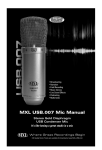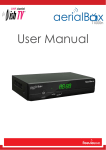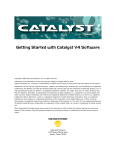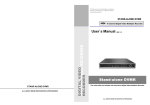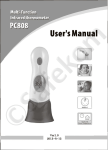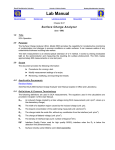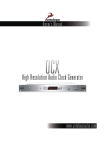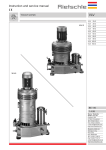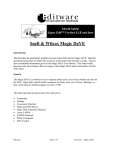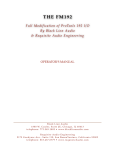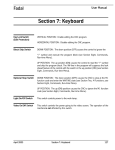Download WIF user manual
Transcript
WIF2 – word clock interface WIF2 word clock interface user manual 14 Hardware Synchroniser for Digital Audio Workstations TABLE OF CONTENTS 1. Front Panel 2. Back Panel 3. Time Code Display I. Time Code Mode II. Status Mode AAAA Pull-Up/Pull-Down Factor BBB Frame Rate Format 1. No Input 2. Video Input Only 3. LTC Input Only 4. VITC Input Only 5. Video & LTC 4. Unit Operation I. Selection of Clock & Time Code Source II. Varispeed 5. Internal DIP Switches I. Midi Cue Mode II. Jam Duration III. Default Standard 6. Specifications -1- 2 4 5 5 5 6 7 7 7 8 8 8 9 10 10 11 11 12 1. Front Panel (6) „lock“ Indicator Indicates when the clock output is locked to an incoming reference. The incoming reference can be an LTC, VITC or video signal. (1) Time Code Display The display has two modes: the Time Code Mode and the Status Mode. In the Time Code Mode the display shows decoded SMPTE time code applied to LTC or VITC input. In the Status Mode the display shows the Frame Rate Format on the left and the Pull-Up/Pull-Down Factor on the right. The Frame Rate Format relates to the frame rate of the incoming time code or to the frame rate of the incoming video signal. The Pull-Up/Pull-Down Factor shows the pullup/pull-down selected by the „Up/x1/Down“ Switch. See the Time Code Display section (p. 5) for more information. (2) „on“ Switch Turns the power to the WIF2 on and off. Each time the MIF3 is powered up, it runs through the display test, shows the software version and the internal dip switch settings. (3) „on“ indicator Indicates proper function of the built-in power supply. (4) „ltc“ Indicator Indicates when a valid LTC signal is detected. (5) „vitc“ Indicator Indicates when a valid VITC signal is detected. Note, when a video signal without VITC is applied, the VITC indicator will not light. -2- (7) „up / x1 / down“ Switch „up“ setting applies the Pull-Up Factor to the 44.1 or 48 kHz sample rate. „x1“ setting leaves the clock at the exact rate of 44.1 or 48 kHz. „down“ setting applies the Pull-Down Factor to the 44.1 or 48 kHz sample rate. If you are not using any Pull-Up or Pull-Down sample rates, set this switch to „x1“ which will let the WIF2 generate the standard 44.1 or 48 kHz sample rates. Whenever this switch setting is changed, the Time Code Display will switch to the Status Mode to display the new Pull-Up/Pull-Down Factor. Please see the Time Code Display sections (p. 5) for further explanation of the pull-ups and pull-downs. (8) „44.1 / 48“ kHz Switch Switches the „x1/ x256“ output clock rate between 44.1 kHz and 48 kHz. The exact sample rate also depends on the position of the „up/x1/down“ switch located just to the left of this switch. If you need to operate at exactly 44.1 kHz or 48 kHz, please set the „up/x1/down“ switch to „x1“. (9) „x1 / x256“ Switch Changes the signal at the „Word output“ Connector between Word Clock and Digidesign’s x256 Superclock. Set the switch to „x256“ when connecting the WIF2 to Digidesign’s 888 or 882 interface. Set the switch to „x1“ when connecting the WIF2 to any word clock digital audio device. -3- MTC and a low jitter clock output. If the LTC format changes, the Time Code Display will briefly switch to the Status Mode to indicate the new format. For a more detailed description please refer to the Unit Operation section (p. 8): 2. Back Panel (10) „VIDEO input“ Connector This BNC connector accepts any VITC or video signal. A possible source could be a VITC, a black burst or any composite video signal. Even unstable video sources such as consumer VCRs can be used. The input is terminated with a 75 Ohm resistor. In order to avoid double termination do not T-off the signal to other terminated video inputs. When a VITC or video signal is applied, the WIF2 will lock to it and produce a low-jitter clock. Additionally, when a VITC signal is applied, the WIF2 will translate VITC time code into MTC. If the VITC format changes the Time Code Display will briefly switch to the Status Mode to indicate the new VITC format. (11) „WORD output“ Connector This BNC connector outputs a Word Clock or a Superclock depending on the setting of the „x1/256“ switch.Neither the Word Clock or x256 Superclock should ever be daisy chained. One output can properly drive one input. The cable length for a word clock signal should be limited to 4,5 m (15 feet), for the Superclock it has to be kept under 1 m (3 feet). (12) „LTC input“ Connector This RCA connector accepts an unbalanced LTC time code signal. The input circuit exhibits a wide range of sensitivity: -40 to +20 dBu. This allows reliable operation of the unit with nearly all LTC sources. When an LTC signal is applied, the WIF2 will translate it to high-quality -4- (13) „MTC“ Connector This 5-pin DIN connector outputs Midi Time Code (MTC). The MTC signal can be applied to any MIDI interface. For reliable operation use only shielded MIDI cables. For more information, please see the MIDI cue mode section (p. 10). (14) VAC input Use the provided AC power cord to connect the WIF2 to the AC power supply through this connector. 3. Time Code Display The display has two modes: the (I.) Time Code Mode and the (II.) Status Mode. I. Time Code Mode In the Time Code Mode the display shows decoded SMPTE time code applied to LTC or VITC input. The time code appears as hours, minutes, seconds and frames. This is the normal display mode of the WIF2 whenever time code is applied. This mode provides the user with the ability to monitor the incoming time code. II. Status Mode This display mode indicates Frame Rate Format and the Pull-Up/Pull-Down Factor. The Frame Rate Format relates to the frame rate of the incoming time code, or the frame rate of the incoming video signal. The Pull-Up/Pull-Down Factor shows the pull-up/pulldown selected by the „up/x1/down“ switch. The display will remain in the Status Mode in the following two instances: 1. When the unit is powered up and no LTC or VITC signal is present. 2. When only a video signal without VITC is applied to the unit. -5- Otherwise, there are two other instances in which the display briefly switches to the Status Mode before reverting to the Time Code Mode: 1. Whenever the format of the LTC or VITC input changes. 2. Whenever the „up/x1/down“ switch is toggled. In fact, toggling the“up/x1/down“ switch is the easiest way to redisplay the Status Mode information. In the Status Mode, the 4 rightmost digits of the display always indicate the Pull-Up/Pull-Down Factor. The 3 left digits show the Frame Rate Format which carries various meaning depending on the signals applied to the WIF2. BBB AAAA AAAA Pull-Up / Pull-Down Factor In the Status Mode, the 4 rightmost digits of the display show the Pull-Up/Pull-Down Factor engaged by the „up/x1/down“ switch. This factor is applied to either 44.1 kHz or 48 kHz base sample rate. The following table helps you interpret the numbers. Pull-Up/PullDown Factor 1.000 1.041 0.960 1.001 0.999 Description No pull-up or pull-down. Sample Rate will be exactly 44.1 or 48 kHz. PAL pull-up (25/24 or 4% change in the Sample Rate) PAL pull-down (24/25 or 4% change in the Sample Rate) NTSC pull-up (1001/1000 or 0.1% change in the Sample Rate) NTSC pull-down (1000/1001 or 0.1% change in the Sample Rate) Remember the Pull-Up/Pull-Down Factor works in conjunction with the „44.1/48“ switch to determine the exact sample rate of the clock outputs. -6- BBB Frame Rate Format 1. No input When the unit is powered up and no signal is applied to either LTC or VITC connector, i.e. WIF2 is not locking to any reference, the Frame Rate Format follows to the default standard which can be defined by the internal DIP switch 8. The table shows the Pull-Up/Down Factors applied by the „up/x1/down“ Switch. Frame Rate Format Default Standard Up Down 25 30 25 fps 30 fps 1.041 1.001 0.960 0.999. 2. Video Input Only When a video signal without VITC is applied to the „Video input“ connector, the Frame Rate Format indicates the frame rate of the applied video signal. The following table relates the Frame Rate Format with the video standard. The table shows the PullUp/Down Factors applied by the „up/x1/down“ Switch. Frame Rate Format Video Standard Up Down 25 29. PAL / SECAM NTSC 1.041 1.001 0.960 0.999. 3. LTC Input Only When an LTC signal is applied to the „LTC input“ connector, the Frame Rate Format indicates the time code format of the applied LTC signal. The following provides a summary. The table shows the PullUp/Down Factors applied by the „up/x1/down“ Switch. Frame Rate Format Time Code Format Up Down 24 25 29d 30 30 24 fps 25 fps 29.97 fps drop frame 29.97 fps non drop frame** 30 fps 1.041 1.041 1.001 1.001 1.001 0.960 0.960 0.999. 0.999. 0.999. ** Note, the WIF2 detects 29.97 non drop frame format as 30 fps when 29.97 fps LTC is applied without any video signal. This will cause a pull down by 0.1%. This Pull-down can be corrected by setting the „Up/x1/Down“ Switch to the Up position. This problem only occurs with 29.97 non drop format. -7- 4. VITC Input Only If there is only an LTC signal present, the WIF2 uses the LTC as positional and clock reference. This means that the word clock output is locked to the LTC input. The time code data from the LTC is translated to the MTC output. If there is a LTC signal and a video signal present at the same time, the WIF2 uses the LTC signal as positional reference for the MTC output and the video signal as clock reference for the word clock output. If there is a VITC video signal present, the WIF2 uses this video signal as clock reference and the VITC as positional reference. If VITC-video and LTC are present at the same time, the video signal is used as clock reference and the LTC is used as positional reference. If the LTC signal falls out of range because the source machine is stopped, jogged or shuttled, the unit switches automatically to VITC for positional reference. Once the LTC is restored to play speed, the unit switches back to LTC as the source time code reference. At all points „LTC“ and „VITC“ LEDs of the front panel indicate the time code source. Automatic switch-over is a special feature of the WIF2 because it always guarantees the selection of the best possible time code. II. Varispeed Many digital audio systems are capable of varispeed operation. The equipment will follow the change in the master clock speed up to some percentage, typically +-10%. The WIF2 supports varispeed operation when deriving the master clock from LTC. If the LTC is gradually changed the clock will follow the change to keep digital audio equipment in sync. The deviation from the nominal play speed that will be tracked is limited to 10%. This is to prevent the errors that occur in many digital audio workstations when this limit is breached. If the LTC speed changes dramatically, which happens when the LTC source machine stops or shuttles, the WIF2 will not follow the change. In this case the unit will continue generating the clock at the sample rate just before the LTC went out of range. In other words the WIF2 exhibits „sample rate memory“. This sample rate memory serves to dramatically reduce LTC lock up time. Once the LTC returns back to useful range, the WIF2 will relock and gradually adjust the clock to match the new LTC speed. Similary, whenever LTC disappears the unit will continue generating clock without any glich. The unit remembers the last sample rate and continues to freewheel at that rate. Note: you may not want the clocks to continue at the off-speed rate due to a previous off-pich operation. To reset WIF2 clock to nominal frequency turn the unit off or toggle the „Up/x1/Down“ switch. -8- -9- When an VITC signal is applied to the „Video input“ connector, the Frame Rate Format indicates the frame rate of the applied VITC signal. The following tablel relates the Frame Rate Format with the VITC format. The table also shows the Pull-Up/Down Factors applied by the „up/x1/down“ Switch. Frame Rate Format VITC Format Up Down 25 29d 29. PAL NTSC drop frame NTSC non drop frame 1.041 1.001 1.001 0.960 0.999. 0.999. 5. Video and LTC When an video signal without VITC is applied to the „Video input“ connector and an LTC signal is applied to the „LTC input“ connector at the same time, the Frame Rate Format indicates the time code format of the applied LTC signal. The following table relates the Frame Rate Format with video standard and the LTC format. The table also shows the Pull-Up/Down Factors applied by the „up/x1/down“ Switch. Frame Rate Format Video Standard LTC Format Up Down 25 29d 29. PAL NTSC NTSC 25 fps 29.97 fps drop 29.97 fps non drop 1.041 1.001 1.001 0.960 0.999. 0.999. Note, the LTC format must mach the corrosponding video standard! 4. Unit Operation I. Selection of Clock & Time Code Source 5. Internal DIP Switches The WIF2 unit has eight internal DIP switches to preset the synchronizer. To get the information how these eight internal swiches are set, it is not necessary to open the box, because in the power up routine the display shows the current settings as abbreviations.The routine starts with the display test 8.8.8.8.8.8.8.8. and shows the firmware version briefly SoFt 2.10 followed by the midi cue mode (dip 1-3) and the jam duration (dip 7) FuLL J8 and remains in the status mode as long as no LTC or VITC signals are applied. 25 1.0 00 The table below lists the functions of the DIP switches and the according display abbreviations: DIP-No. 1-2-3 Settings Abbreviation. 0-0-0 1-0-0 0-1-0 0-0-1 1-0-1 oFF FuLL Loc qFb qFb-2 0 1 0 1 J8 J32 25 30 7 8 Function midi cue mode no output during jog/shuttle MTC Full Message MMC locate command quarter frame bursts quarter frame bursts-2 Jam Durationtion 8 frames 32 frames default standard 25 fps default standard 30 fps Unfortunately many devices which are using MTC do not have implemented the Full message. For that reason the WIF2 supports some other midi cue modes for locating or cueing your sequencer / audio workstation frame accurately to a master time code. One of these methods to cue up a DAW is the use of the MMC „Locate“ command, if the slaved DAW supports MMC slave mode together with MTC slave mode. Therefore set the midi cue mode to Locate. (for example with Digidesign ProTools 4.2, Roland VS-880, Fostex FD8...) Then the WIF2 outputs an MMC locate command instead of the Full message. Other recording software can be located by a burst of several quarter frames. The Creamware Triple DAT Software, for example, works fine with the midi cue mode qFb-2. II. DIP 7, Jam Duration The time code drop out correction bridges up to 8 frames. DIP switch 7 sets the error correction to 32 frames. This causes also a post-roll time of 32 frames after the master time code has stopped. III. DIP 8, Default Standard The default standard setting defines the time code standard when the unit is powered up. I. DIP 1-3, Midi Cue Mode Midi Time Code is the standard used to translate SMPTE time code into MIDI messages. There are two basic types of messages, described as Quarter Frame and Full message. The Quarter Frame message is used for normal running status at play speed. The Full message communicates a specific time for locating or cueing. - 10 - - 11 - 6. Specifications LTC input RCA female, -40 to 20 dBu, 10k ohms 0,5 to 200% of playspeed, reverse and positional, format auto-detection (24, 25, 30 drop, 30 fps) Video input BNC female, 75 ohms terminated PAL/NTSC Composite Sync reads VITC in lines 6 to 22 MIDI output 5-pin DIN, The Complete MIDI 1.0 MTC quarter frame and full messages MTC quarter bursts, MMC locate Word output BNC female, 75 ohms, TTL x1 or x256 sample rate, 42.336, 44.056, 44.100, 44.144, 45.937 kHz 46.080, 47.952, 48.000, 48.048, 50.000 kHz Lock range +/- 10% of nominal speed Clock jitter < 1 ns per audio frame Resolution 23 ppm Power Euro EN 60.320, 230 VAC, 50 Hz, 30 mA, (115 VAC, 60 Hz, 60 mA version also available) LED Display 8 x HP 7503, 6mm (0,3“) red Dimensions 11,4 cm W x 3,1 cm H x 16,8 cm D, 1U-19“ rackmount kit available Weight 0,7 kg - 12 -







